
Edward Winter
A postcard-size copy of the painting below was sent to us on 31 October 1985 by the late Adriano Chicco, inscribed by him on the reverse:

Can readers provide information about the picture?
(3019)
Mauro Torelli (Milan, Italy) writes:
‘The picture appears (in black and white) on the front page of the book Prontuario del problemista by the well-known Italian problemist Gino Mentasti (published by Scacco!, 1977). It is referred to as a painting by M. Fratta entitled “La soluzione è vicina” (“The solution is near at hand”).’
(3041)
Below is a painting by Sir Wyke Bayliss of Santa Croce, Florence:
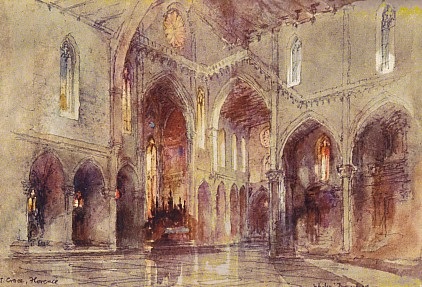
(3361)
For further information about Sir Wyke Bayliss see Chess Jottings.
Calle Erlandsson (Lund, Sweden) informs us that during a recent visit to the Stockholm Chess Union he took photographs of two works of art on its premises.
‘The first is a huge painting (about 5m x 2m) of 33 chessplayers by the Finnish artist Antti Favén (1882-1948). It was owned by the late Erik Lundin and was donated to the Union. The 33 players are more or less well known, with Siegbert Tarrasch in the background. Perhaps C.N. readers can identify the others.
The second work is a portrait of Alexander Alekhine by Gabriel Strandberg (1885-1966), donated to the Union by Uno Hedin on 2 September 1997.’
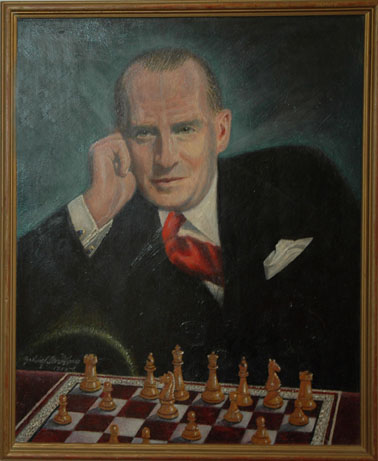
We note that this is based on the photograph of Alekhine which was, for instance, the frontispiece to the first (1939) edition of My Best Games of Chess 1924-1937:
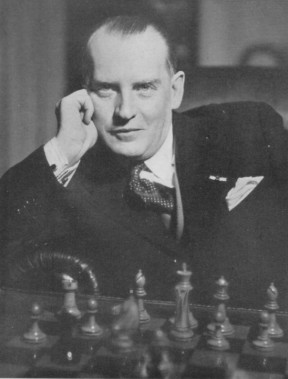
(3730)
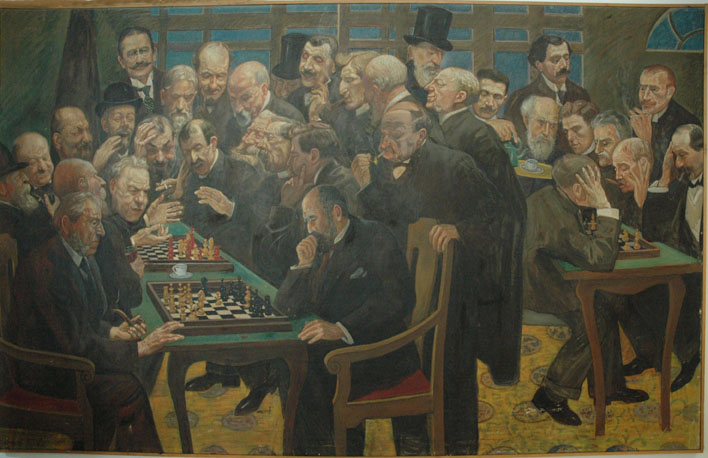
Little progress has yet been made in identifying the players. Tarrasch is clearly in the top left-hand corner, and the figure in the centre background, with a cigar, is Marshall. Is Alekhine lighting a cigarette in the centre foreground? Moreover, Gerhard Josten (Cologne, Germany) suggests that the man seventh from the right is Emanuel Lasker.
(4277)
From Antero Leitzinger (Helsinki):
‘According to the chess column in a Finnish newspaper, Svenska Pressen, 29 October 1932, Antti Favén offered his painting as a prize at the annual Finnish championship tournament. In his speech, Favén referred to his friendship with Marshall and other players at the Café de la Régence, which suggests that the painting portrayed those players. The painting and a copy of it (I do not know which is the original) adorn the walls of the Stockholm Chess Union and of Shakkikoti, a chess club room in Helsinki. According to Calle Erlandsson in C.N. 3770, the former picture was donated by Erik Lundin, which is confirmed by Eero E. Böök in his article in the 10/1980 issue of the Finnish chess magazine Suomen Shakki, pages 294-295. Lundin himself, however, made no mention of acquiring the painting in his memoirs Erik Lundin spelar upp sina schackminnen 1924-1979 (Skara, 1979).
Under the rules set out in Favén’s speech, as quoted in Svenska Pressen, the painting was to be awarded to whichever player won the Finnish championship three times. This means that Böök should have received it in late April 1936. However, in the newspaper Uusi Suomi, where Böök had a weekly chess column at the time, no mention was made of his receiving the painting after the tournament. Nor did Böök explain in his later (1980) article why the painting ended up in Sweden, but he did reproduce the picture with suggestions as to the identities of some of the figures: Tarrasch (in the background), Marshall (with a cigar), Janowsky (with a cigarette, on Marshall’s right), Burn (seated in front of Marshall, with a pipe), and Bernstein (facing Burn). On the basis of a Swedish pamphlet, Böök claimed that Favén produced the painting over a long period, from 1902 to 1913.
Page 29 of a publication by a Finnish art museum, Antti Favén 1882-1948 (edited by Ulla Huhtamäki, Hämeenlinnan taidemuseon julkaisuja 3, Toijala, 1992), mentions Favén having worked on his painting in autumn 1910. It also refers to a Finnish newspaper, Nya Pressen, of 4 October 1910, but the date is incorrect, as there was nothing about Favén in that issue.
Yrjö Antti Favén was a cosmopolitan Finn, born in Helsinki, who lived in Paris for many years, working in the rue Saint-Senoch. In 1938 or 1939 he finally moved to Sweden, and in 1946, only two years before his death, he became a Swedish citizen.’
A question which arises is whether Faven’s painting depicts players whom he met at the Café de la Régence or, indeed, whether some of the portraits were based on photographs and others were fictional.
(4420)
Avital Pilpel (Haifa, Israel) mentions that Tarrasch in the painting (top left-hand corner) has clearly been based on the photograph of him which was given on page 183 of Chess Facts and Fables:
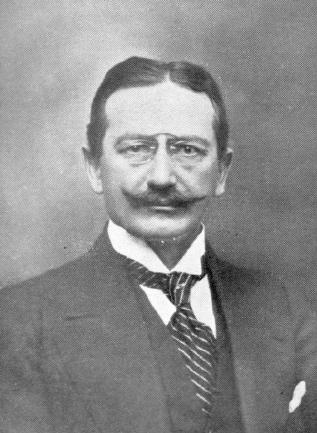
We gleaned it from the special Tarrasch issue of Kagans Neueste Schachnachrichten, 1922, although it evidently dates from many years earlier. The following shot was published opposite page 161 of La Stratégie, May 1913:
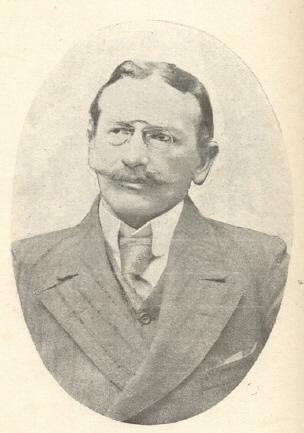
Michael Macdonald-Ross (Wheathampstead, England) comments that the portrayal of Tarrasch in the painting suggests the early 1900s, which would explain the absence of Capablanca, Rubinstein and Alekhine, although he is surprised not to find Teichmann or Pillsbury. He also suggests that since Blackburne wore a goatee he may be the figure in the bowler hat.
(4427)
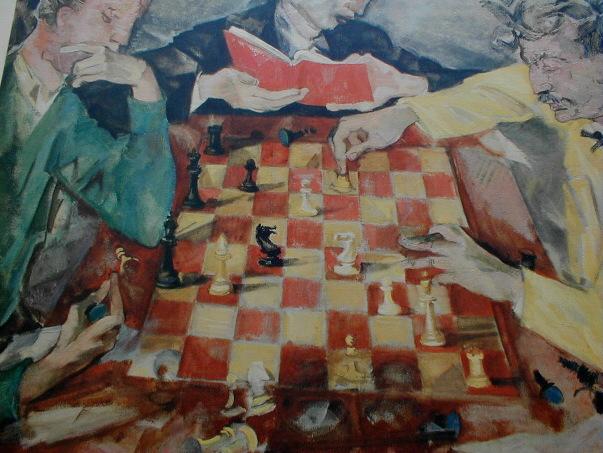
Mark N. Taylor (Mt Berry, GA, USA) sends the above picture and observes:
‘This is Maximilian Mopp’s “Chess with Emanuel Lasker”, of which I have a print (“Copyright 1953. Arthur Rothmann Fine Arts, Inc., N. Y. C.” ). Can anyone identify the position on the board, Lasker’s opponent, or the third figure? Mopp is perhaps best known to chessplayers as the illustrator of Edward Lasker’s Chess for Fun & Chess for Blood.’
(4091)
Jack O’Keefe (Ann Arbor, MI, USA) sends us a copy of the dust-jacket of the first edition of Chess for Fun & Chess for Blood by Edward Lasker (Philadelphia, 1942):
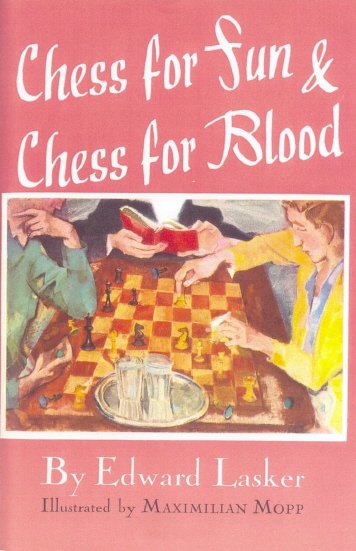
(4348)
Nicolas Sphicas (Thessaloníki, Greece) draws our attention to a large number of paintings by him with a chess theme. [22 June 2022: replacement link.]
(4185)
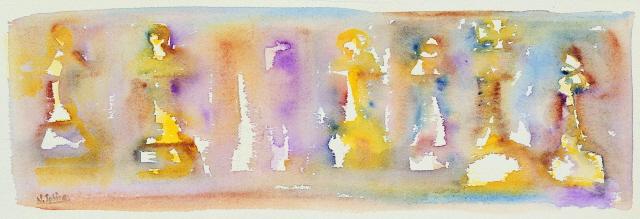
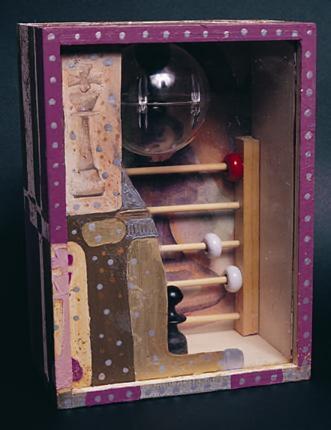
The above pictures have been sent to us by Nicolas Sphicas (Thessaloníki, Greece), who informs us that they depict two Capablanca games (respectively, against Rubinstein at San Sebastián, 1911 and against Flohr at Moscow, 1935). C.N. 4185 mentioned that much of our correspondent’s other chess artwork can be viewed on-line.
We are also grateful for the 56-page catalogue of an exhibition of his work at the Municipal Art Gallery of Thessaloníki in 2008:
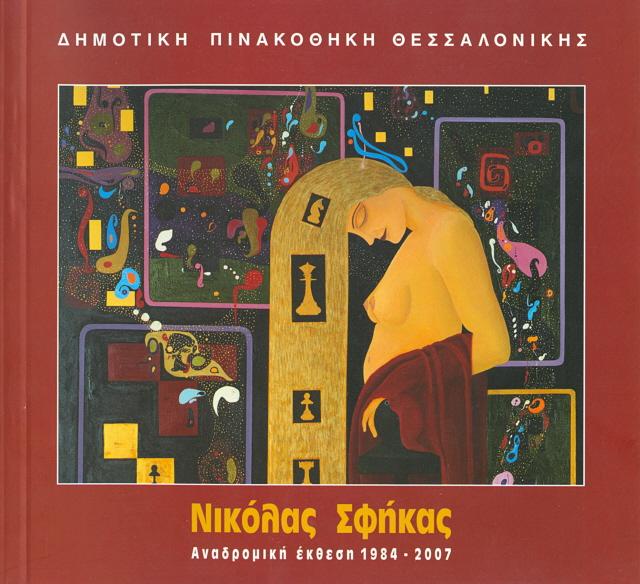
Further acknowledgement in connection with the present item: Michael Syngros (Amarousion, Greece).
(6041)
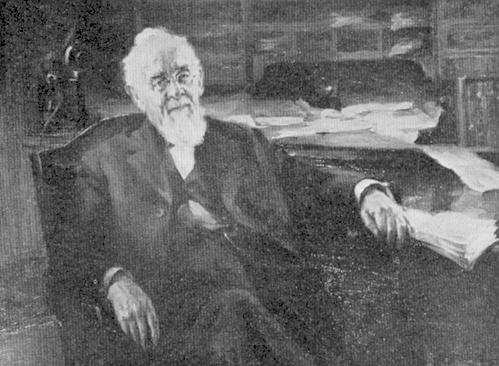
This picture appeared at the front of a souvenir issue of The Gambit, June 1930. The caption reads:
A colour version may be viewed at the Cleveland Public Library website. [22 June 2022: updated link.]‘The late John Griswold White. Portrait by Sandor Vago. Painted for the White Collection.’
(4205)
Eric Fisher (Hull, England) has shown us a painting by Samuel Boden (1826-82) which he acquired at an auction in 2002:
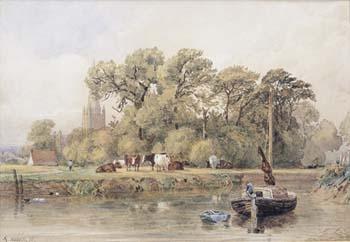
The catalogue described it as follows: ‘Norwich from the River, water colour, signed lower left. 25.5 x 37cm. Provenance: Ex Bonhams, 15 March 1980.’
Our correspondent is seeking further information about Boden’s art. On pages 167-168 of the Chess Monthly, February 1882 an obituary referred in general terms to Boden as a landscape painter and art critic, also describing him as ‘one of the best chessplayers England ever produced’. Page 31 of the Chess Player’s Chronicle, 18 January 1882 stated that ‘on coming into some property, through the death of a relative, he entirely devoted himself to art’.
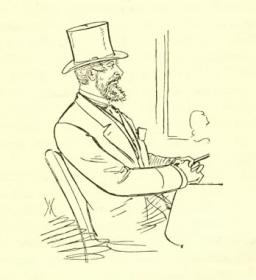
Samuel Standidge Boden (Chess Life-Pictures by G.A. MacDonnell, page 35)
(5007)
Paintings of Emanuel Lasker by L. Nardus and M. Mopp were presented in C.N.s 3715 and 4091 respectively, and the work below was the frontispiece of Lasker’s Uchebnik shakhmatnoi igri (Moscow and Leningrad, 1926):
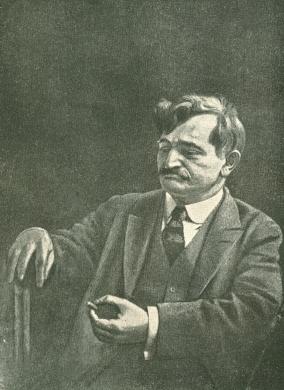
A further painting on which information will be appreciated was on the front cover of the January 1963 Chess Review:
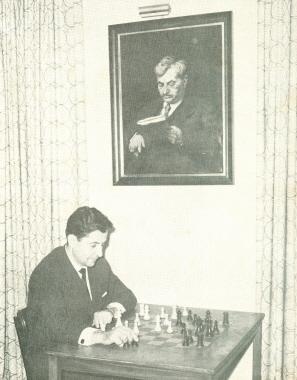
The player at the board is Petar Trifunović, during a visit to the United States. The same painting was on page 61 of the February 1973 Chess Life & Review (obituary of Morris J. Kasper):
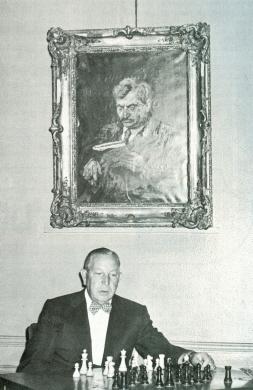
(5071)
David DeLucia (Darien, CT, USA) mentions that he owns one of the paintings of Lasker featured in C.N. 5071 and he has kindly authorized us to reproduce the illustration below:
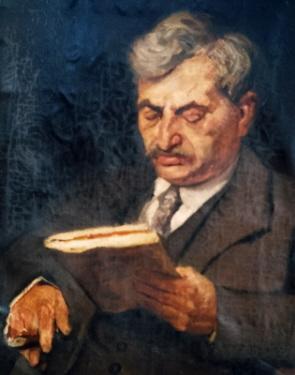
(5103)
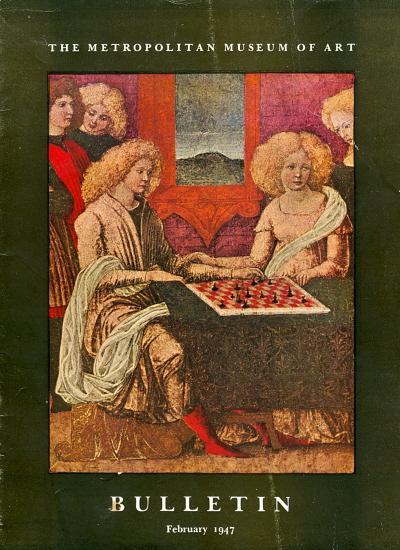
Pages 153-156 of the February 1947 Bulletin of the Metropolitan Museum of Art featured an article entitled ‘The Chess Players by Francesco di Giorgio’, and readers are left to decide how fanciful the writer, Harry B. Wehle, was in his description on pages 153-154:
‘Evidently the young man has already won, for his left hand holds one of the black chessmen and none of his adversary’s pieces remain on the board. The youths in the audience appear well pleased with the outcome of the game, whereas the maidens betray distress. The players themselves are moved by emotions of far more complicated sorts – and here Francesco di Giorgio proves himself a master of facial expression. Instead of feeling frankly triumphant as one would have anticipated, our hero has fallen into a state of discomfited indecision. For the lovely defeated heroine the game is already a forgotten episode, and as she gazes into space with sweetly solemn eyes she rests her right hand tenderly upon the arm of her recent opponent. Can it be, one asks oneself, that the poor creature has become infatuated with her vis-à-vis?’
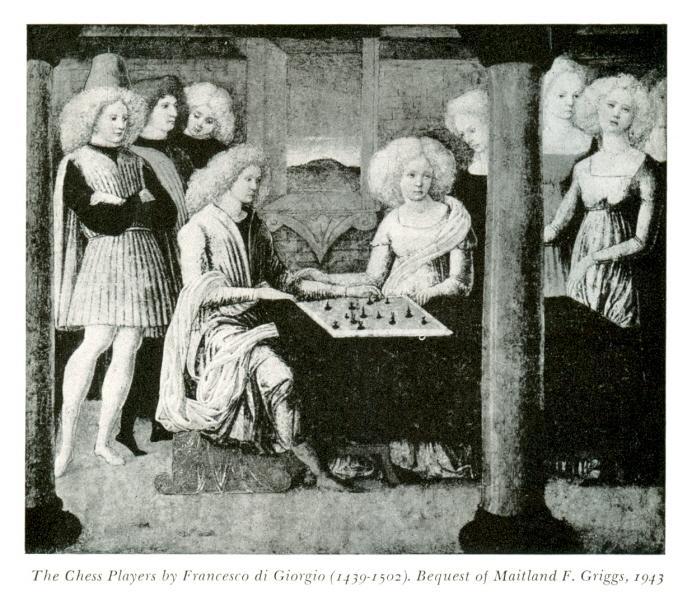
From page 155 of the February 1947 Bulletin
The board position and the board are certainly intriguing:
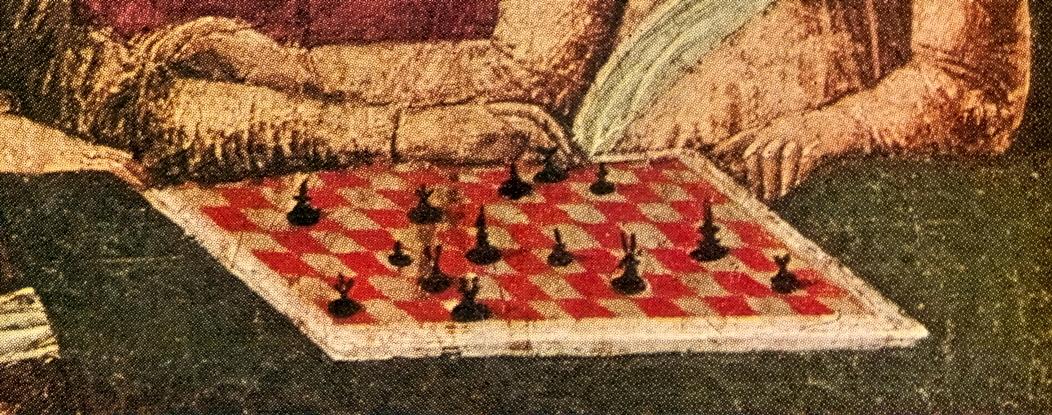
(5206)
Csaba Gerencsér (Veszprém, Hungary) refers us to the webpage of the Hungarian painter Sándor Badacsonyi. [22 June 2022: updated link.]
The front cover of Mr Gerencsér’s 1995 book Tízezer Lépés Morphyval has a picture by Badacsonyi. See Morphy v the Duke and Count.
(6401)
The frontispiece of British Chess by Kenneth Matthews (London, 1948):
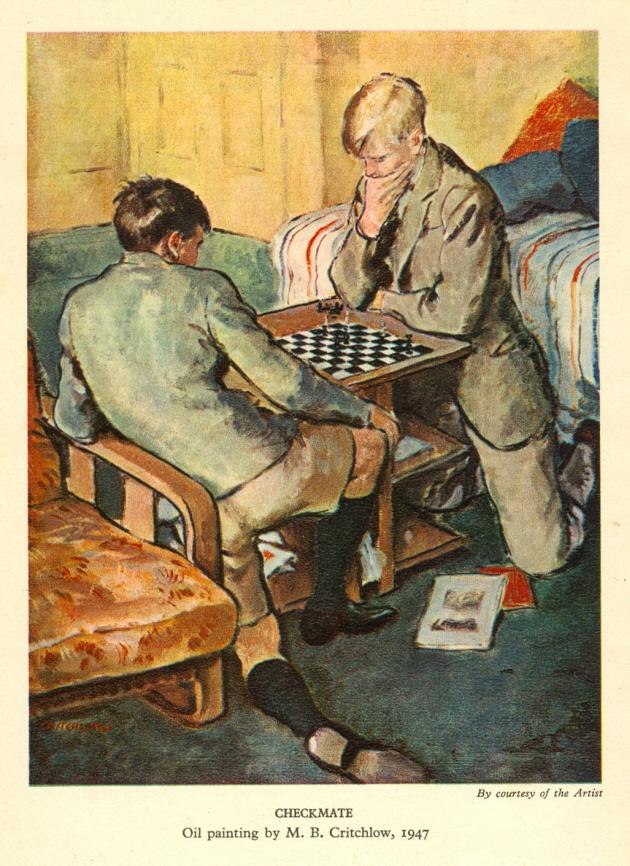
(7423)
Eduardo Bauzá Mercére (New York, NY, USA) notes a report on page 22 of the New York Tribune, 14 August 1892 that the painter Jean-Louis Ernest Meissonier (1815-91) considered his chef d’oeuvre to be ‘The Chess Players’:
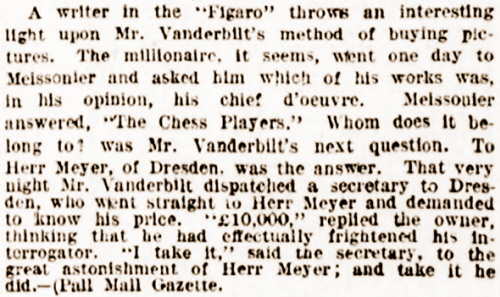
Mr Bauzá Mercére writes:
‘A painting of that name was one of the first by Meissonier to be presented publicly, at the Paris Salon in 1836. A different work with the same title was apparently produced in 1856. To complicate matters, there is a third chess-related painting by him, called “Game of Chess” (“Partie d’échecs”), dating from 1841. Which of the three pictures was bought by Vanderbilt?’
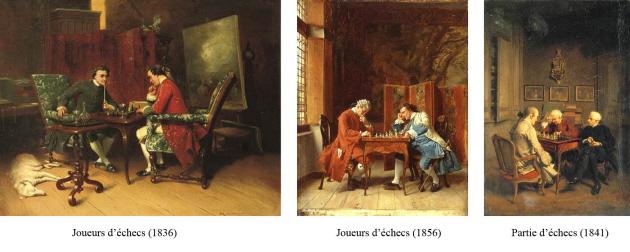
We add a sketch of Meissonier from page 491 of Living Leaders of the World (Chicago and St Louis, 1889):
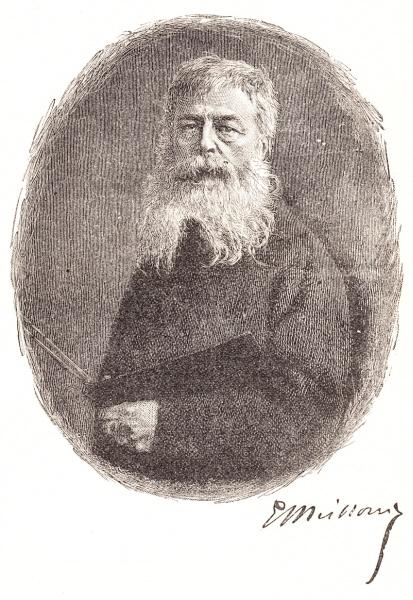
(7595)
Michael Clapham (Ipswich, England) refers to the entry on Meissonier (four paintings) on pages 18-19 of Chess in Art by Manfred Roesler (Davenport, 1973). It is reproduced here with the permission of the editor, Bob Long (Davenport, IA, USA):
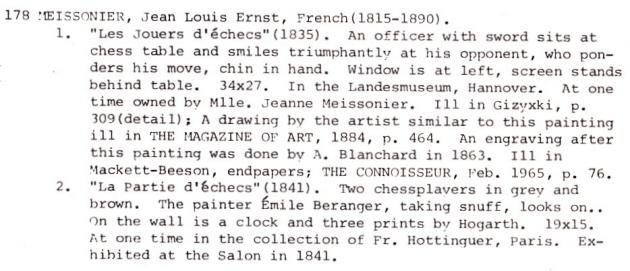
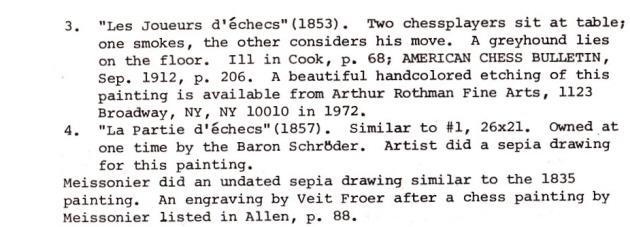
(7599)
Wanted: information about paintings by Bernhard Horwitz. On page 210 of the May 1846 issue of Le Palamède Saint-Amant wrote:
‘M. Horwitz, peintre allemand distingué, a établi son chevalet au milieu du salon des Echecs, et manie alternativement ses pinceaux et les pièces de l’échiquier. Il lutte de combinaisons avec tous les membres et les immortalise ensuite sur sa toile.’
(8479)
John Townsend (Wokingham, England) has found this item in The Times, 8 June 1886, page 2:

(8487)
From a ‘Chess Movies’ article on the inside front cover of the January 1959 Chess Review:
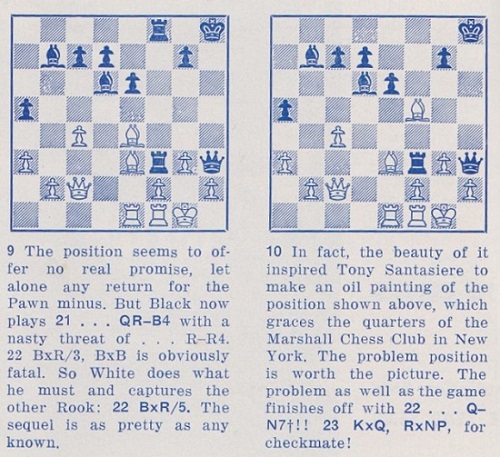
Concerning the painting by A.E. Santasiere depicting the game in question, A Brilliancy by Hermann Helms, Ronald Young (Bronx, NY, USA) reports that he saw the picture hanging in the Marshall Chess Club in 2003 and noted that the position reproduced was not precise. He asks whether a photograph can be obtained.
We are grateful to Frank Brady (New York, NY, USA) for taking the following photograph of the painting, which is still in the Marshall Chess Club’s possession:
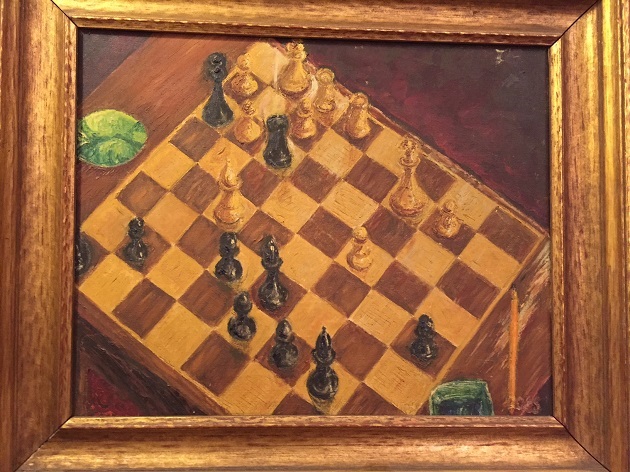
(9110)
A photograph of Anthony Edward Santasiere from page 110 of the April 1943 Chess Review:
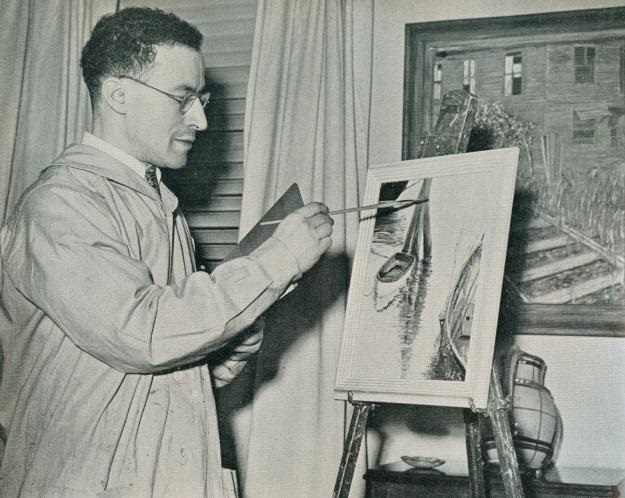
Nick Blackett (Brisbane, Australia) informs us that he owns two paintings by Carslake Winter Wood (1849-1924), of Bergues Belfry and Katz am Rhein:
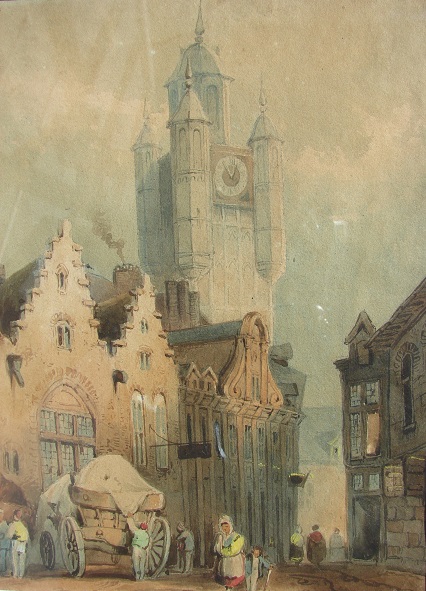
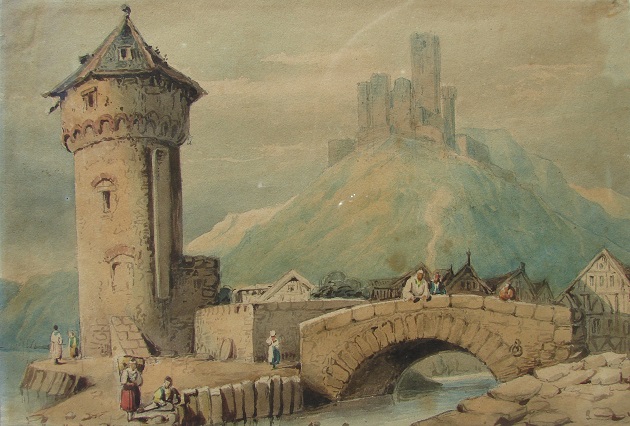
A photograph of Winter Wood was published on page 28 of The Chess Bouquet by F.R. Gittins (London, 1897):
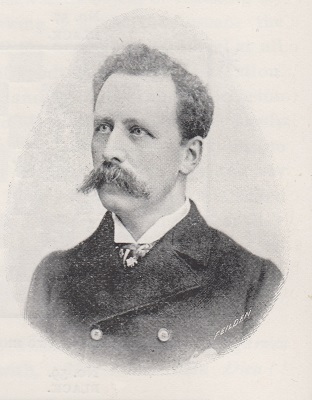
A biographical article on pages 280-281 of the June 1891 BCM referred to his interest in art:
‘... he lived for several years with his maternal uncle, Major Sole, at Torquay; with whom and Mrs Sole he travelled through many of the European countries, spending several winters on the Riviera and the lakes of Italy, where he acquired and cultivated a taste for painting, and, for an amateur, displays skill of no mean order of merit; several specimens of his work he has given as chess prizes in various competitions.’
Wanted: more information about the painting of Burger on page 132 of the May 1963 Chess Review:

(10935)
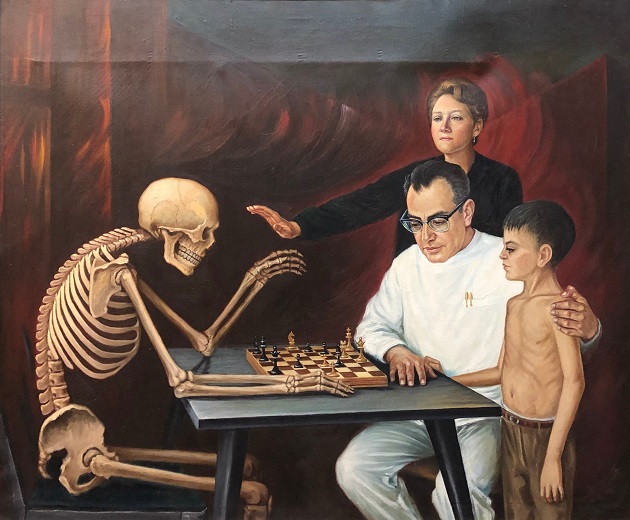
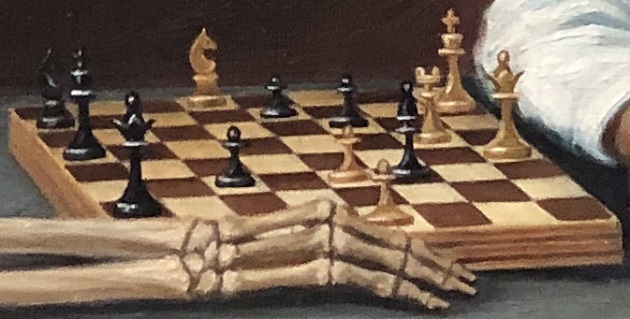
Olivia Segura Ortiz (Mexico City) has sent us this photograph of a painting commissioned by her grandfather, Dr Alfredo Lejarza, to depict his fight for the life of a dangerously ill boy in a game of chess against Death. Our correspondent’s grandmother is calling on Death to stop and to allow the boy to live.
This information corrects what appeared on page 275 of the Whitsun 1963 CHESS, an item which is in our feature article Chess and Ghosts:

(11246)
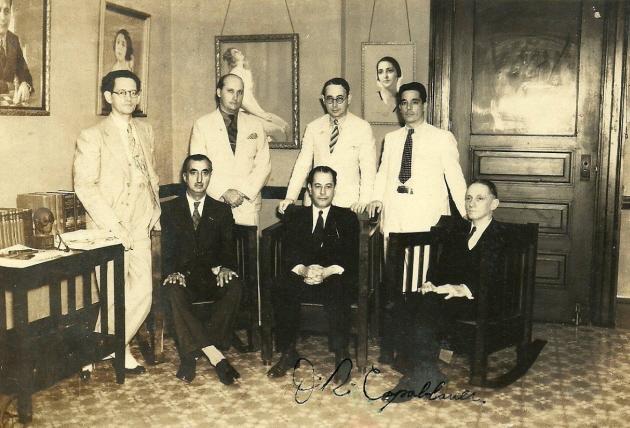
This photograph, with Capablanca seated in the centre, was given in C.N. 7727, courtesy of its owner, Ross Jackson (Raumati South, New Zealand).
Part of a painting of Capablanca is visible on the wall:
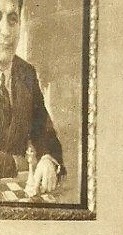
Olimpiu G. Urcan (Singapore) notes that the portrait is by Esteban Valderrama, as shown in the 11 June 1933 edition of Diario de la Marina:
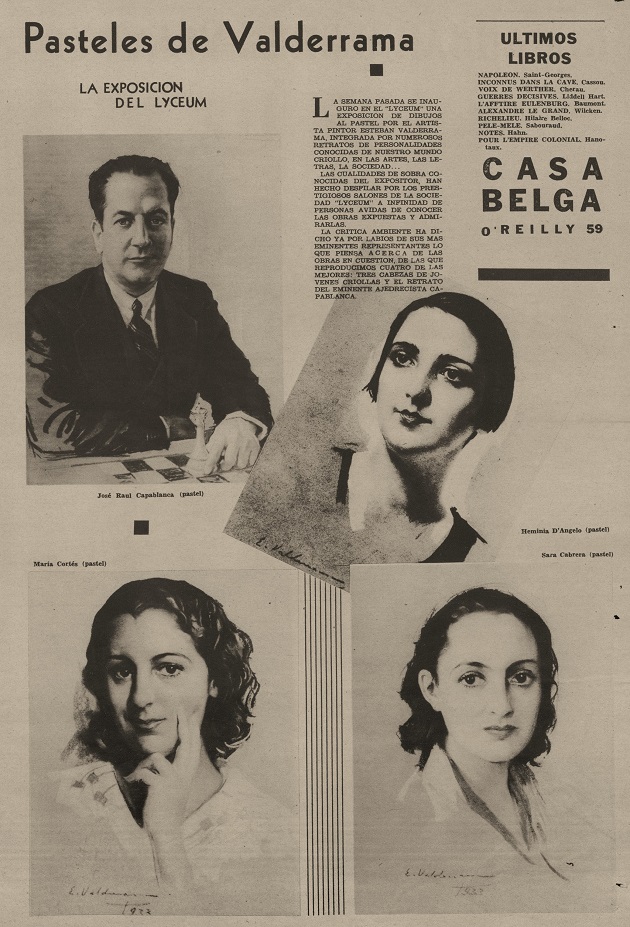
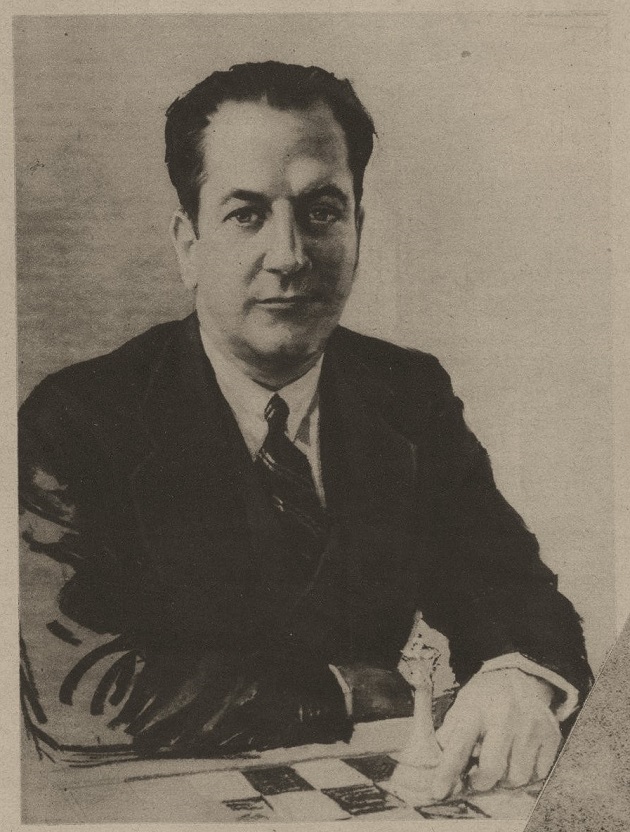
A painting of Capablanca by Valderrama dated 1938 is the frontispiece of The Immortal Games of Capablanca by Fred Reinfeld (New York, 1942) and is on the front cover of the 1990 Dover edition:
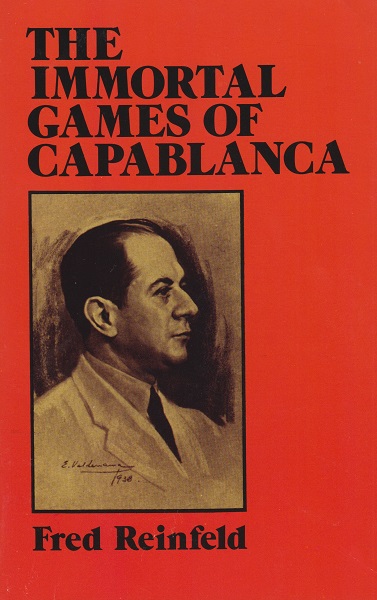
(11563)
Ross Jackson reports that he owns a copy of Capablanca’s A Primer of Chess (New York, 1935) inscribed to Esteban Valderrama:
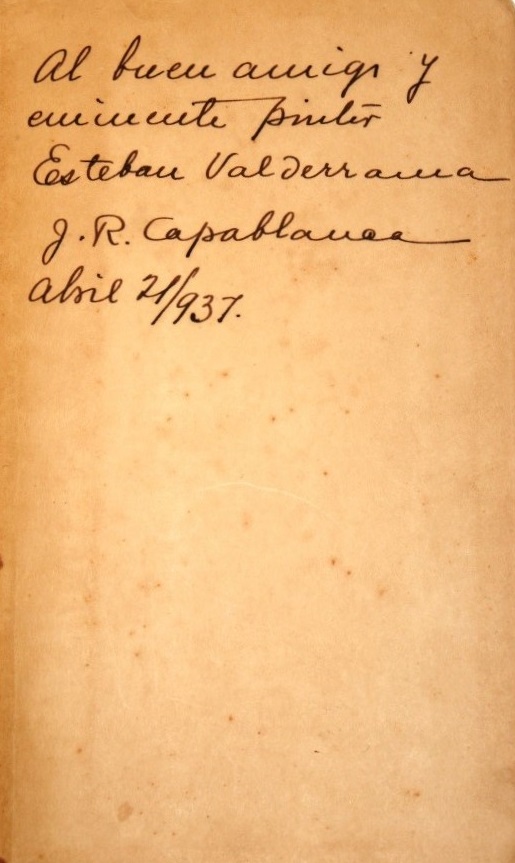
Michael Clapham (Ipswich, England) possesses a large (68cm x 52cm) print of Valderrama’s portrait, with an indistinct inscription by the artist in the top right-hand corner:
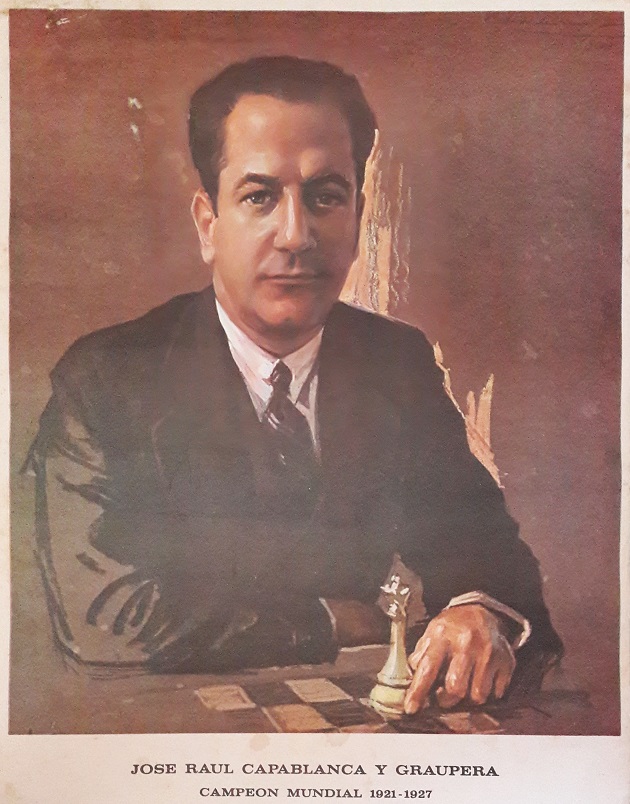
(11574)
From page 19 of the book on the 1966 Olympiad in Havana:
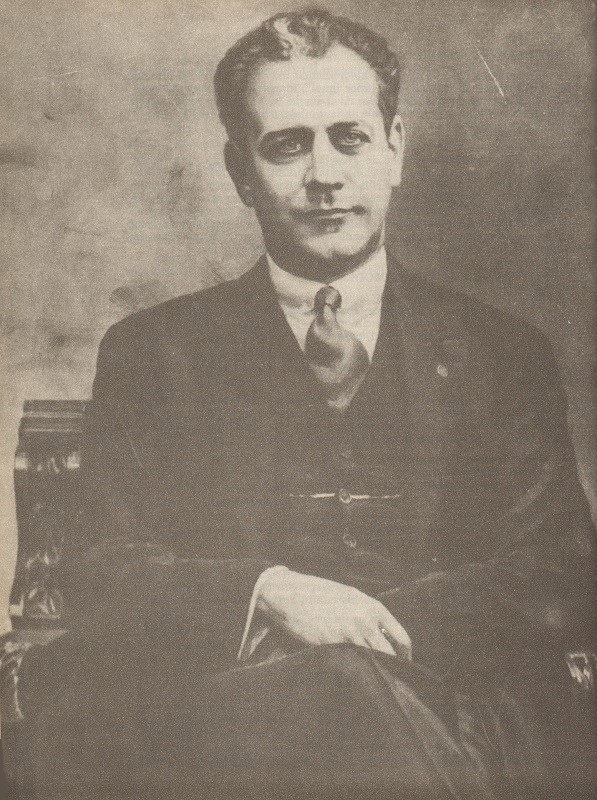
Wanted: more information about this painting, which is based on the Bad Kissingen, 1928 group photograph.
Page 362 of the October 1971 BCM gave this shot:
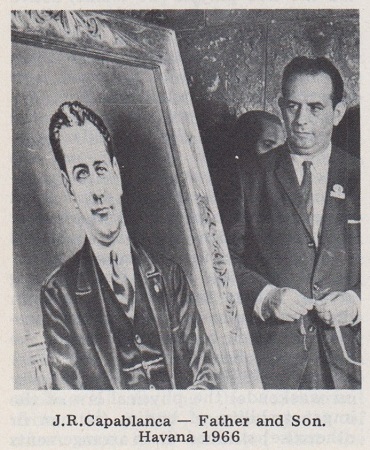
Two appearances of the painting on the front cover of the Cuban periodical Jaque Mate:
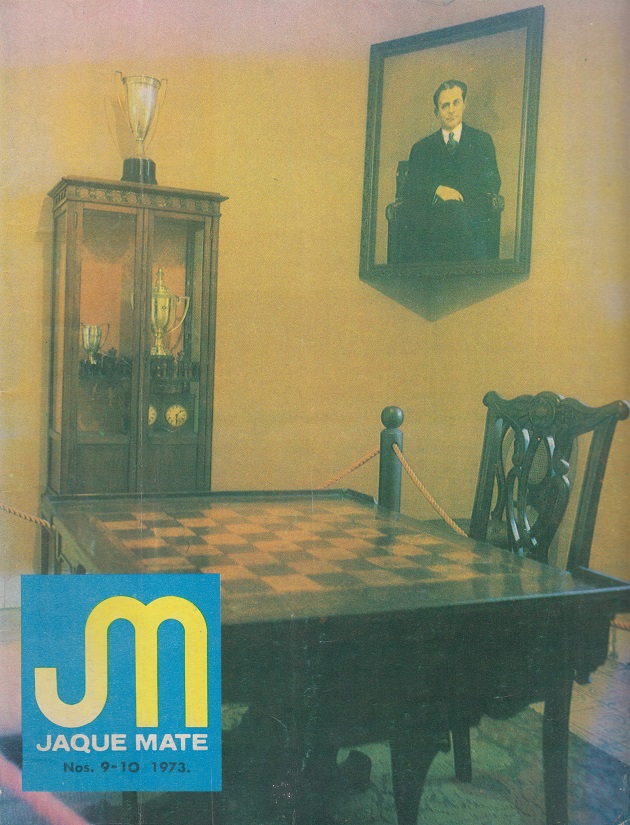
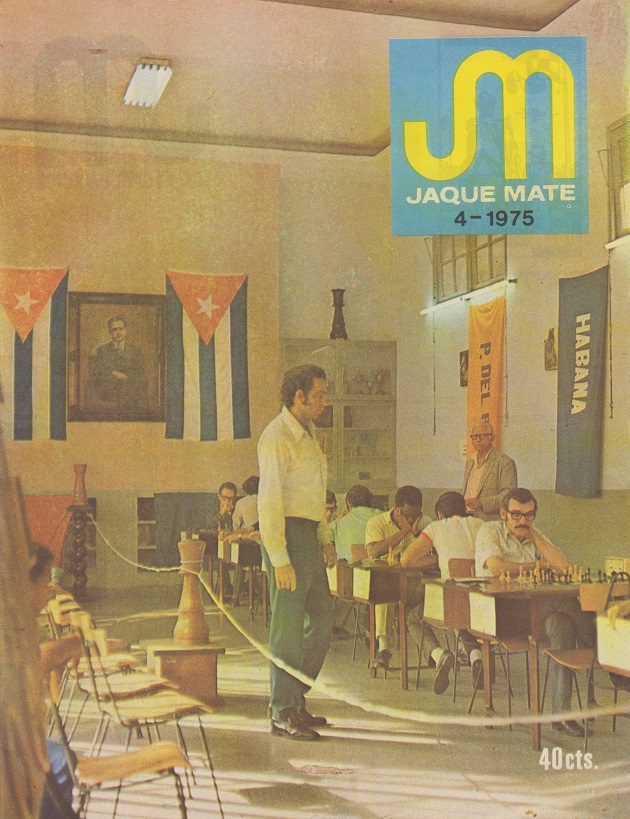
The photograph below, showing a commemoration of the 1921 world championship match, was taken at the National Museum of Sports, Havana by Bernardo Alonso García and was sent to us in 1994 by Armando Alonso Lorenzo (Prov. Ciego de Avila, Cuba):
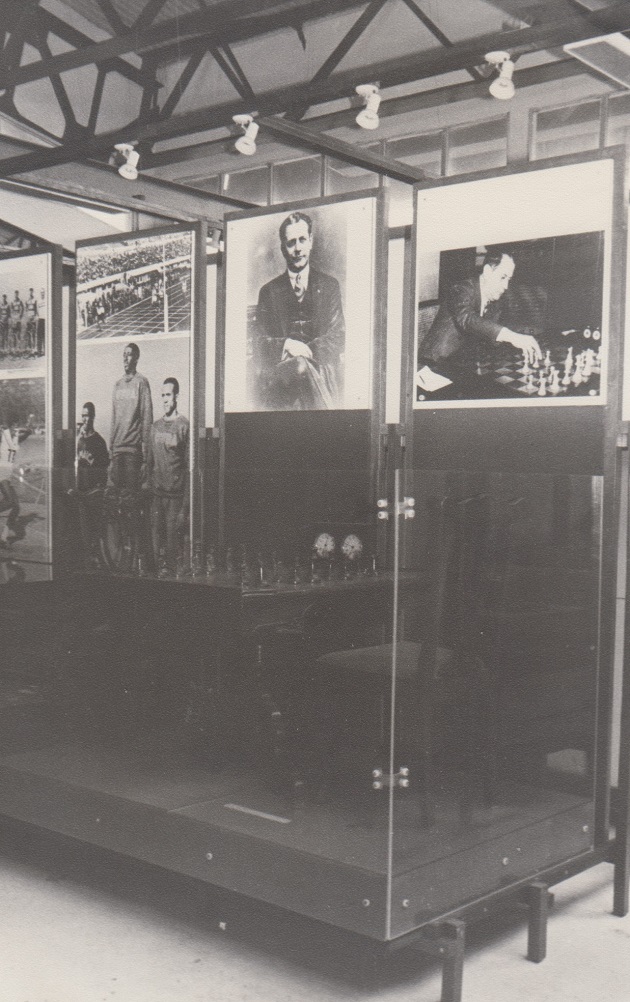
(11662)
See too:
To the Chess Notes main page.
To the Archives for other feature articles.
Copyright: Edward Winter. All rights reserved.